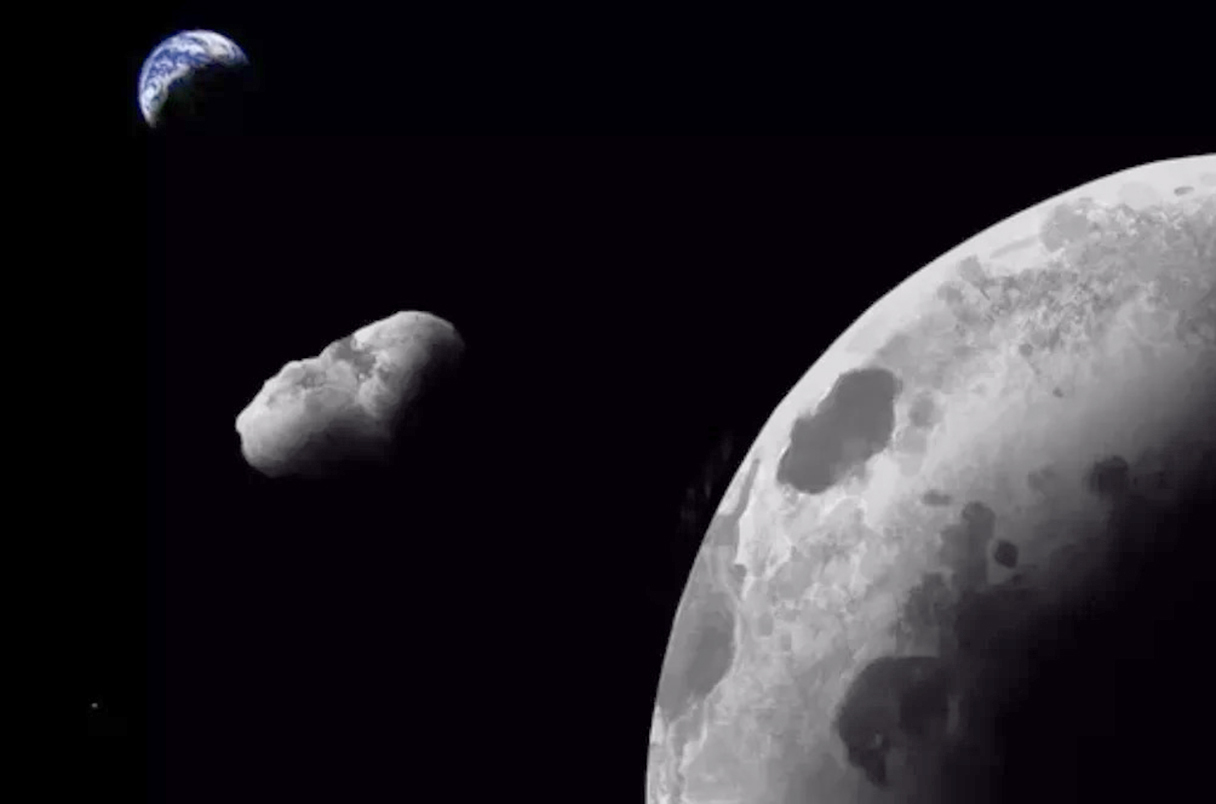25.05.2025
The target, flying in a rare quasi-satellite orbit, could be a piece of the Moon

An artist’s illustration of the asteroid Kamo‘oalewa, which could be a blasted-off chunk of Earth’s MoonADDY GRAHAM/UNIVERSITY OF ARIZONA
Following its successes retrieving lunar samples from both the near and far sides of the Moon, China is planning an encore, sending a probe to snatch material from a near-Earth asteroid.
The target of the Tianwen-2 mission, which is expected to launch by the end of the month, is a chunk of rock named 469219 Kamo‘oalewa. It is one of just seven asteroids that fall into a little-understood class known as quasi-satellites of Earth—and it could also be the first known asteroid comprised of lunar material. That hypothesis could be confirmed by laboratory studies of fragments collected by Tianwen-2, which are due to be returned to Earth about 2.5 years after launch.
“This is an ambitious mission to explore a fascinating object,” says astrophysicist Amy Mainzer of the University of California, Los Angeles.
Kamo‘oalewa was discovered in 2016 by the Pan-STARRS 1 asteroid survey telescope on Haleakalā in Hawaii. It travels in a highly elliptical solar orbit and appears to Earth-bound observers to be alternately leading and trailing Earth in its more circular orbit. This gives the impression the asteroid orbits Earth. Kamo‘oalewa has been in its current orbit for about 100 years and will likely remain there for another 300, according to a study by brothers Raúl and Carlos de la Fuente Marcos, both of the Complutense University of Madrid. Shifting orbits are typical of quasi-satellites, and Kamo‘oalewa roughly means “oscillating celestial fragment” in Hawaiian.
China set its sights on Kamo‘oalewa because its unique orbit, unknown origin, and undetermined characteristics make it “highly valuable for scientific exploration,” planetary scientists Li Chunlai and Liu Jianjun of China’s National Astronomical Observatories jointly wrote in an email to Science. Announced in early 2019, the mission “could potentially answer questions about the origin of Earth’s quasi-satellites and the evolution of their orbits,” the pair wrote.
After China announced the mission, further studies made Kamo‘oalewa even more interesting. The first surprise came after University of Arizona planetary scientist Benjamin Sharkey and colleagues aimed the Large Binocular Telescope, located on Mount Graham in Arizona, at the object. “We had presumed it would be a typical asteroid,” says Sharkey, now at the University of Maryland. But the telescope picked up a very atypical spectrum, or pattern of reflected light, that suggested Kamo‘oalewa is made up of silicates resembling those found in Apollo lunar samples. Among other plausible origins, the asteroid might have been ejected from the Moon’s surface as the result of a collision with some other astronomical object, Sharkey and his team wrote in Communications Earth & Environment in 2021.
Intrigued by that possibility, Tsinghua University planetary scientist Cheng Bin and colleagues ran numerical simulations to determine which lunar impact craters had the right size, location, and age to be associated with Kamo‘oalewa. The Giordano Bruno crater, which is 22 kilometers in diameter and 1 million to 10 million years old, ticked all the boxes. Further simulations indicated that at least one body of the right size could have escaped the Moon’s gravitational pull, avoided collisions with other space objects, and end up in a quasi-satellite orbit, the group reported in Nature Astronomy in 2024.
A third paper, appearing in The Astrophysical Journal Letters in January, argues that the reflectance spectrum of another near-Earth asteroid, named 2024 PT5, also “matches lunar samples.”
“The lunar impact hypothesis is gaining additional support,” says Sharkey, a co-author of the recent Astrophysical Journal Letters paper. But, “Observations and the ejecta models do not yet prove it.” Analyzing the samples in an Earth-based lab could “settle the question (of origin) definitively,” Mainzer says.
Getting samples, however, will be a challenge. Tianwen-2 is the world’s fourth asteroid sample return mission, following Japan’s two Hayabusa probes and NASA’s OSIRIS-REx. But those missions targeted far larger asteroids; Kamo‘oalewa, at 40 to 100 meters across, would fit comfortably within a standard soccer field. Navigating to such a small object “requires highly sophisticated cameras, spacecraft computers, and reaction control systems,” Mainzer says. Kamo‘oalewa also rotates every 28 minutes, much faster than any of the other visited asteroids. With near–zero gravity, large soil grains have likely been flung off the asteroid, leaving behind “a shallow regolith containing very small grains,” Cheng says.
Previously, the Hayabusa missions and OSIRIS-REx probe collected their asteroid samples using a “touch-and-go” technique in which the spacecraft hovers close to the surface while a robotic arm fires a projectile or burst of gas to knock fragments into a collection chamber. Tianwen-2 will first hover close to the asteroid and extend a robotic arm to probe surface conditions and pick up weathered particles. Then it will deploy a sample collector with a pair of rotating brushes to sweep up fragments and a stream of gas to blow them into a container. Depending on surface conditions, Tianwen-2 might also attempt what engineers call the “anchor-and-attach” approach. The spacecraft will extend three legs and land, then use a claw on the robotic arm to grab onto the asteroid while the sample collector does its job.
If Kamo‘oalewa does prove to be a Moon fragment, “it would let us test our knowledge of impact physics and ejection against a major cratering event,” Sharkey says. And even if it isn’t, research on the samples could lead to unforeseen “breakthrough scientific achievements,” Li and Liu say.
If all goes well, Tianwen-2’s mission won’t end at the asteroid. After releasing its return capsule, the probe will use a gravity assist from Earth to speed toward comet 311P/PANSTARRS, arriving about 7 years later. A suite of remote sensing instruments will search for clues to the origin and evolution of the early Solar System and whether comets provided Earth’s water and the building blocks of life.
Quelle: AAAS
